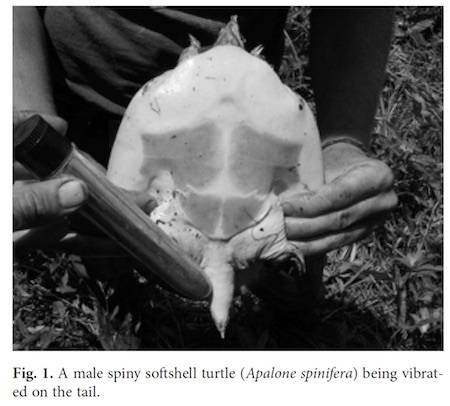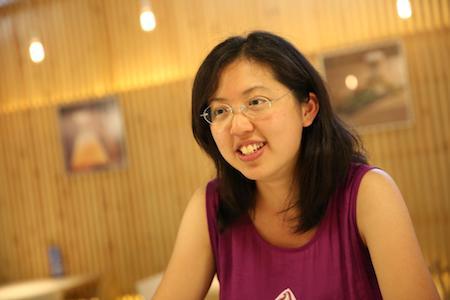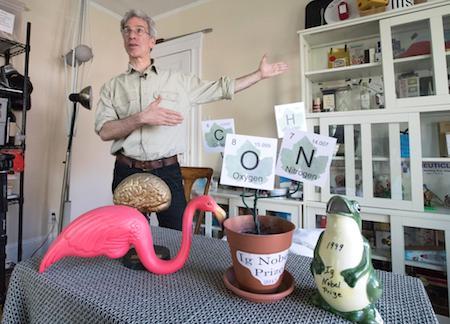Marc Abrahams's Blog, page 214
July 24, 2017
“Good Vibrations: A Novel Method for Sexing Turtles” [research study]
Vibrators can be used, in a stimulating way, to study the sex of turtles. This study tells how.
“Good Vibrations: A Novel Method for Sexing Turtles,” Donald T. McKnight, Hunter J. Howell, Ethan C. Hollender, and Day B. Ligon, Acta Herpetologica, vol. 12, no. 1, 2017, pp. 117-121. The authors, at Missouri State University, James Cook University, and Towson University, report:
“While most species of turtle exhibit secondary sexual dimorphisms that can be used to reliably infer sex, there are some species that are very difficult to sex, and even within many dimorphic species, it is not uncommon to encounter individuals that appear to exhibit both male and female secondary sex characteristics. Therefore, we tested the novel method of using a vibrator to sex turtles by stimulating male turtles to evert their penises. We tested this method on males of four species (three families) with known sexual dimorphisms: spiny softshell turtles (Apalone spinifera; n = 14), western chicken turtles (Deirochelys reticularia miaria; n = 17), Mississippi mud turtles (Kinosternon subrubrum hippocrepis; n = 10), and common musk turtles (Sternotherus odoratus; n = 9). The method accurately sexed 100% of A. spinifera, 64.7% of D. r. miaria, 80.0% of K. s. hippocrepis, and 55.6% of S. odoratus.”
Sternotherus odoratus, which remains difficult to sex, is also known as the “stinkpot turtle.”
NOTE: One form of vibrator is called a “rabbit vibrator.” It is not the specific kind of vibrator that was used in the study. Nor was the so-called “tame little turtle shape vibrator.”
BONUS: A performance, by humans, of the song “Good Vibrations”:

Toilet paper papers – a partial resumé
 Following on from our recent note regarding ‘A Time/Cost Assessment of Toilet-Paper Folding, Worldwide’ may we also recommend a non-exhaustive selection of other toilet paper papers which may be perused at your convenience :-
Following on from our recent note regarding ‘A Time/Cost Assessment of Toilet-Paper Folding, Worldwide’ may we also recommend a non-exhaustive selection of other toilet paper papers which may be perused at your convenience :-
● A System for Identifying Toilet User by Characteristics of Paper Roll Rotation
● Objective Hand Measurement of Toilet Paper
● Are Three Sheets Enough? Using Toilet Paper To Teach Science & Mathematics
● The Invention of Toilet Paper
● Unrolling the Roll: Toilet Paper as a Socially Constructed Symbolic Artifact
The photo is courtesy of Brandon Blinkenberg at Wikipedia

July 21, 2017
Whistled languages – like ‘local cellular phones’ (study)
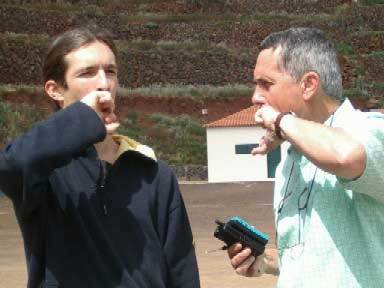 “Whistled languages are a valuable heritage of human culture.” – explained a 2004 paper : ‘Bioacoustics of human whistled languages: an alternative approach to the cognitive processes of language’ (in : An. Acad. Bras. Ciênc. vol.76 no.2, June 2004).
“Whistled languages are a valuable heritage of human culture.” – explained a 2004 paper : ‘Bioacoustics of human whistled languages: an alternative approach to the cognitive processes of language’ (in : An. Acad. Bras. Ciênc. vol.76 no.2, June 2004).
It was authored by Dr. Julien Meyer of the Laboratoire de Dynamique du Langage (DDL)-CNRS, Institut des Sciences de l’Homme (ISH), Lyon, France, and described a survey about a new multidisciplinary approach :
“Whistled languages can be regarded as a transposition of a given local language into a repertoire of whistles.“
The survey concluded that :
“ . . . whistled languages are products of human intelligence and not just curiosities or ‘surrogates’ in the pejorative sense. They show a widespread distribution across cultures and have obviously developed quite independently of each other, but mostly related to a particular local environment. They are quite clearly defined and represent an original adaptation of the spoken language, like a ‘local cellular phone’ for the needs of isolated human groups.”
Also do not miss : Les langues sifflées – from the Association de recherche Le Monde Siffle (The World Whistles Research Association) – which hosts audio examples from Mexico, Greece, Turkey, and of course the Canaries – home of ‘Le Silbo’ as pictured above.

July 19, 2017
Ig Nobel Tickets go on sale THURSDAY, JULY 20, at NOON
Tickets for the 27th First Annual Ig Nobel Prize Ceremony go on sale THURSDAY, JULY 20, 2017, at noon (US eastern time). We expect (based on experience) the tickets will get snapped up quickly.
The Harvard Box Office handles all ticket sales. The physical ticket office [now in a temporary location in Farkas Hall, 10 Holyoke Street, Cambridge] is open some (but not all!) days from noon to 6 pm.Telephone (+1) 617-496-2222.
The web site is open 24 hours, every day.
Tickets: $75 / $65 / $55 / $35
Student tickets: $70 / $60 / $50 / $30
Ig Glorious tickets: $150. We fund the ceremony (theater rental, and half a zillion other expenses) mainly through ticket revenues. We are offering a few special “Ig Glorious” tickets, for persons who want to be specially supportive. Ig Glorious tickets come with special perks: Excellent seats; A vintage copy of the Annals of Improbable Research, signed by an emissary; Their photo taken at the Ig Nobel lectern on stage (before or after the ceremony, at the discretion of the Stage Manager); Access to our Ig Glorious Liaison, a staff member assigned to the “Ig Glorious” group for the entirety of the event; And a hearty handshake!
THE CEREMONY
The ceremony will happen at the usual place.
WHERE: Sanders Theatre, Harvard University
WHEN: THURSDAY, SEPTEMBER 14, 2017, 6:00 pm.
Ceremony details.

July 18, 2017
The Museum of Menstruation
 If you are, or ever have been, or ever might be involved with human reproduction, you will probably learn interesting things by visiting the Museum of Menstruation.
If you are, or ever have been, or ever might be involved with human reproduction, you will probably learn interesting things by visiting the Museum of Menstruation.
The museum currently exists online, and is looking for a physical home in or near New York City, a metropolis in which human reproduction is believed to occur with some frequency.

July 17, 2017
A visit to the world of the Ig Nobel Prizes
Journalists from Mirror Media journeyed halfway around the world to visit Ig Nobel headquarters in Massachusetts (Part 1 / Part 2 / Part 3), and also visit an Ig Nobel Prize winner (Patricia Yang) at her lab in Georgia (Part 1 / Part 2 / Part 3). You can see and hear what they found, in two three-part reports and a short video.
BONUS INFO: Tickets for the 27th First Annual Ig Nobel Prize ceremony go on sale this Thursday, July 20, exclusively from the Harvard Box Office.
BONUS: Here’s a Taiwanese animation about the Ig Nobel Prizes:

Interrupting people : the pros and cons
 What might you gain (or lose) by interrupting someone? The question has been experimentally examined by Professor Sally Dew Farley, of the Psychology department at the University of Baltimore, US. Experimental subjects who had been asked to discuss an article were systematically interrupted by confederates – revealing the following :
What might you gain (or lose) by interrupting someone? The question has been experimentally examined by Professor Sally Dew Farley, of the Psychology department at the University of Baltimore, US. Experimental subjects who had been asked to discuss an article were systematically interrupted by confederates – revealing the following :
• The Upside for the Interrupters : “Interrupters gained in status and targets of interruption lost status.”
• The Downside for the Interrupters : “As expected, interrupters, especially female interrupters, were liked less than those who did not interrupt.”
Source: ‘Attaining Status at the Expense of Likeability: Pilfering Power Through Conversational Interruption.’ in the Journal of Nonverbal Behavior, Volume 32, Number 4, 241-260
Further resources: A very comprehensive selection of scholarly papers about interruptions – from Adamczyk P. D. to Zou L. – can be found here.

July 16, 2017
“God is a Porcupine—Brain, Consciousness and Spacetime Physics” [research study]
 Sometimes the title is enough to give a deep understanding of an entire research paper. Here’s an example, a study called “God is a Porcupine—Brain, Consciousness and Spacetime Physics,” by Walter J. Christensen Jr. of California State University Fullerton, published in the Journal of Modern Physics, July 2017.
Sometimes the title is enough to give a deep understanding of an entire research paper. Here’s an example, a study called “God is a Porcupine—Brain, Consciousness and Spacetime Physics,” by Walter J. Christensen Jr. of California State University Fullerton, published in the Journal of Modern Physics, July 2017.

July 13, 2017
Bees also like (paintings of) sunflowers (study)
“Flower colours have evolved over 100 million years to address the colour vision of their bee pollinators.” With this in mind, investigators Professor Lars Chittka and Julian Walker of Queen Mary College, University of London, decided to investigate whether bees might also be attracted to paintings of flowers – for example (a copy of) Van Gogh’s Sunflowers.
A set of experiments demonstrated that, yes, they are : “[…] when bees were confronted with paintings containing flowers, the majority of landings were indeed recorded on flowers.”
See: Do bees like Van Gogh’s Sunflowers? , L. Chittka, J. Walker / Optics & Laser Technology 38 (2006) 323–328
Note: The photo is from a follow up study by the same team. Chittka, L. & Walker, J. (2007). ‘Insects as art lovers: Bees for Van Gogh.’ Antennae, 2: 37-42.

July 11, 2017
Biscuits-with-No-Added-Sugar-Containing-Stevia,-Coffee-Fibre-and-Fructooligosaccharides News
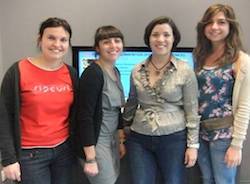 There’s big news for anyone with a keen interest in biscuits with no added sugar containing stevia, coffee fibre and fructooligosaccharides.
There’s big news for anyone with a keen interest in biscuits with no added sugar containing stevia, coffee fibre and fructooligosaccharides.
Details are in this new study: “Biscuits with No Added Sugar Containing Stevia, Coffee Fibre and Fructooligosaccharides Modifies α-Glucosidase Activity and the Release of GLP-1 from HuTu-80 Cells and Serotonin from Caco-2 Cells after In Vitro Digestion, ” Nuria Martinez-Saez, Christina Maria Hochkogler, Veronika Somoza, and Maria Dolores del Castillo, Nutrients, 2017, 9(7), 694.
The authors are at Universidad Autónoma de Madrid and the University of Vienna. Here’s further detail from the study:

Marc Abrahams's Blog
- Marc Abrahams's profile
- 14 followers


